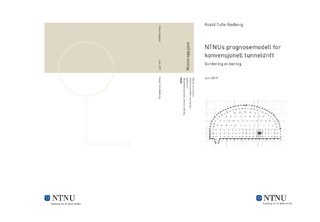| dc.contributor.advisor | Jakobsen, Pål Drevland | |
| dc.contributor.author | Rødberg, Roald Tufte | |
| dc.date.accessioned | 2019-10-26T14:05:20Z | |
| dc.date.available | 2019-10-26T14:05:20Z | |
| dc.date.issued | 2019 | |
| dc.identifier.uri | http://hdl.handle.net/11250/2624716 | |
| dc.description.abstract | NTNUs prognosemodell for konvensjonell tunneldrift er et empiribasert verktøy for planlegging av utførelsesmetoder og for estimering av inndrift og kostnader ved bruk av boring og sprenging som drivemetode. Siste revisjon av prognosemodellen ble foretatt i 2007, og gjennom indikasjoner fra næringslivet har det kommet frem at resultater og forslag til utførelse som NTNU-modellen gir, ikke alltid samsvarer med den praksis som utøves. Det foreligger derfor et ønske om å undersøke modellens relevans i forhold til metoder og fremgangsmåter som i dag benyttes for boring og sprenging av tunneler.
Denne masteroppgaven har som formål å sammenligne praksis fra dagens tunnelbransje med resultater og anbefalinger fra NTNUs prognosemodell for konvensjonell tunneldrift. Gjennom arbeidet med oppgaven har det blitt avdekket forskjeller mellom anbefalt borhullsmengde fra prognosemodellen, sammenlignet med den borhullsmengde som benyttes på tunnelprosjekter i dag. Mulige årsaker til hvorfor disse avvikene foreligger har også blitt presentert og drøftet.
Vitenskapelig forskningsarbeid fordrer bruk av ulike metoder for innhenting, analyse og diskusjon av informasjon. Disse har blitt redegjort for og diskutert for å sikre reliabilitet og validitet. Første steg i arbeidet var undersøkelse av eksisterende litteratur innen gjeldende tema. Dette har blitt utført ved hjelp av et litteratursøk for å identifisere dagens forskningsfront, samt utvide forfatters egen kunnskapshorisont. Funn herfra har dannet grunnlaget i masterens teoridel. Oppgavens primæranalyse er en komparativ analyse hvor tverrsnittsdata fra ulike veitunnelprosjekter har blitt sammenlignet med de anbefalinger NTNU-modellen gir for tilsvarende tverrsnitt. Data fra de totalt 55 tverrsnittene har blitt innsamlet gjennom kontakt med bransjen. Det forelå også et ønske om å knytte forskningsarbeidet til et pågående tunnelprosjekt, og det har derfor blitt gjennomført et case-studie. Studieobjektet som har blitt undersøkt er et veitunnelprosjekt i Norge, og funn herfra har blitt benyttet til å underbygge resultater fra den komparative analysen.
Basert på gitte antagelser har den komparative analysen avdekket at den borhullsmengde entreprenører benytter i dag generelt er høyere enn anbefalinger fra prognosemodellen. For innsamlede tverrsnitt med medium sprengbarhet har gjennomsnittlig differanse i borhullsmengde blitt funnet til å være 42 hull. Gjennomsnittlig tilsvarer dette en økning på 22,8 % sammenlignet med prognosemodellens anbefalinger. For tverrsnittsgruppen med dårlig sprengbarhet er det avdekket at det gjennomsnittlig foreligger en differanse på 33 borhull, noe som tilsvarer en økning på 27,3 % i forhold til anbefalingen prognosemodellen gir. Identifiserte mulige årsaker til disse avvikene har blitt funnet til å være endrede konturkrav, forskjell i praksis for entreprenør, teknologisk utvikling for maskiner og utstyr og endrede insentiver.
Avslutningsvis har også anbefalinger til videre arbeid med verifisering av prognosemodellen blitt fremlagt. | |
| dc.description.abstract | The NTNU prediction model for conventional tunnelling is an empirical-based tool for construction planning and for estimation of advance rate and costs when using drill-and-blast excavation method. The last revision of the model was carried out in 2007. Due to recent notions from the industry, the relevance of the results and recommendations provided by the model is questioned. Consequently, a review of the model’s relevance in comparison to common practices in drill and blast tunnelling has been desired.
The purpose of this thesis is to investigate current practices in the tunnel industry compared to results and suggestions for methods of construction yielded by the NTNU prediction model. Through work conducted, existing differences between the recommended number of drill holes from the prediction model, compared with the number of drill holes used in today’s tunnel construction projects have been investigated. Possible reasons for these discrepancies have also been presented and discussed.
Scientific research requires use of different methods for obtention, analysis and discussion of information. These have been accounted for and discussed to ensure reliability and validity. A review of literature and research has been conducted in examination of existing knowledge. This has identified the current state of research, as well as expanded the author’s own knowledge on the topic. Findings from these reviews have contributed to form the theoretical background of the thesis. The primary analysis of the task is a comparative analysis in which cross-sectional data from various road tunnel projects have been compared with recommendations provided by the NTNU model for the given cross-sections. Data from a total of 55 cross sections have been collected through contact with the industry. There was also a desire to link the research work to an ongoing tunnelling project, and a case study has therefore been carried out. The examined object is a road tunnel project in Norway, and findings from this study have been utilized to underpin results from the comparative analysis.
Based on given assumptions, the comparative analysis has revealed that contractors generally use a higher number of drill holes compared to recommendations from the NTNU prediction model. For the collected cross-sections with medium blastability, the average deviation in drill hole quantity has been found to be 42 holes. On average, this corresponds to a 22.8 % increase compared to the prediction model's suggestions. For cross sections in the group with poor blastability, an average deviation of 33 drill holes has been discovered, which corresponds to a 27.3 % increase compared to the model’s provided recommendation. Possible causes of these discrepancies have been identified and reviewed; change in contour requirements, shift in contractor practice, technological development for machinery and equipment, as well as changes in contractors' incentives.
Finally, recommendations for future work on verification of the NTNU prediction model has been presented. | |
| dc.language | nob | |
| dc.publisher | NTNU | |
| dc.title | NTNUs prognosemodell for konvensjonell tunneldrift - Vurdering av boring | |
| dc.type | Master thesis | |
